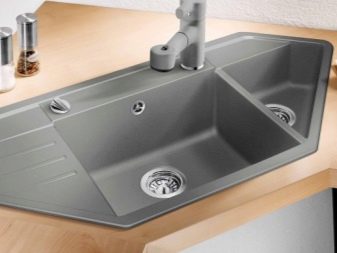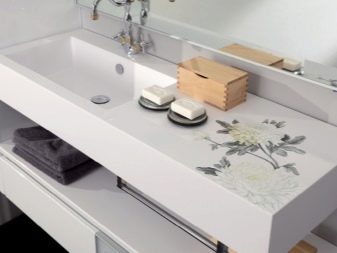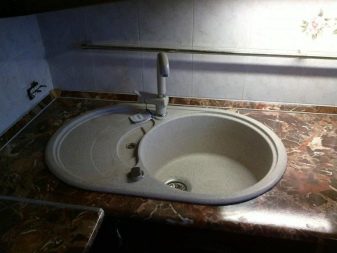Stone sinks: features of use and care

The sink is a very important element of the interior; it has many different functions. It is very important that it is modern, stylish and comfortable. The range of models presented in modern stores is very wide. Stone sinks have gained great popularity among consumers: their discreet, sophisticated look can decorate any interior. Consider the features of using such products and the subtleties of caring for them.



Peculiarities
A stone sink is able to decorate both the kitchen and the bathroom. In the kitchen, an appropriate countertop is selected for it, and a special counter is installed in the bathroom. This unusual sink attracts the attention of everyone in the room. Very often it is the main accent in the interior. Modern manufacturers create stone models from both natural and composite materials.
When choosing a sink made of stone, the question arises of which material to choose - natural or composite. Manufacturers assure that artificial stone outperforms natural stone in a number of parameters. Some manufacturers give a guarantee for several decades.


You need to understand that a sink made of natural and artificial stone is practically the same thing, just different production technologies are used. Artificial stone is obtained by casting and molding. A mixture of mineral components and acrylic resins is used.
This material contains up to 80 percent of natural particles, and only 20 of them are binder resins. In some cases, dye is added. Such material is lighter than stone, it comes in different colors and is in no way inferior in environmental friendliness.
Sinks made of artificial stone are practically silent, the material dampens the clatter of dishes and the noise of falling water. It also provides electrical insulation, which can be an additional plus in the kitchen, where there are electrical appliances and water.


Production
Products made from solid natural stone are the result of a complex technological process. A part is cut from a large piece that is suitable for the future product. It is processed on machine tools. When the rough workpiece is ready, you need to start manual processing. All operations require great skill and special tools.


When making a sink from an artificial stone, the technology is different. The material for it is a composite, which includes natural materials (in the form of chips) and binding elements. These are usually resins and polymers.
Such material is environmentally friendly, it does not cause allergies, does not absorb water and foreign odors, and is more resistant to mechanical stress.
Products made from such a stone are covered with a protective layer - gelcoat. It gives increased resistance to external influences.


Views
Sinks are made from various natural stones: marble, soapstone, onyx, travertine, granite, basalt, sandstone and other materials that can be processed. The natural material is suitable for both monochrome and colored interiors.

- Granite. This is one of the inexpensive materials. It can be either pinkish, reddish or gray. This material is very resistant to aggressive household chemicals, it is easy to clean. This material is the most popular.
- Marble. It has been used since ancient times to decorate palaces and rich houses. This is a great material that immediately sets a "high" tone to the interior. Its shades are usually cold, it does not crack, does not exfoliate, and can withstand significant loads. This material absorbs moisture, which must be taken into account when leaving.


- Onyx. Allows you to diversify the color range of yellow and brown shades. It is also transparent, translucent and shiny, like glass. It is waterproof.
- Basalt. Enriches the color range of stone shells with gray and greenish tones. Basalt lends itself well to processing (despite its rather significant weight). This material tolerates moisture well, it is resistant to chemicals, does not transmit sound.


- Travertine. Usually there is a pattern on a light or dark background. Such material is well processed, it is lighter than basalt. Its peculiarity is its porous surface, which makes maintenance difficult.

The sink can be integrated, made of river stone or petrified wood. Sinks made of artificial material almost do not differ in appearance from natural ones. However, they contain chemical components. The colors and shapes of such materials are very different, they depend only on the imagination of the customer.


Artificial materials are:
- porcelain stoneware;
- fragranite;
- silgranite;
- granitek and so on.


Materials differ in the proportional ratio of natural and synthetic components. The most popular is the material with granite chips, since its surface is not porous. Quartz chips are also often used. With her, the composite is almost impossible to distinguish from natural stone. In the production of acrylic material, white clay is added.


Advantages and disadvantages
Natural stone products vary in shape, color and size. The shape of a product made from natural material usually depends on the type of workpiece. Artificial stone is produced according to certain parameters.

Advantages of a stone sink:
- The stone is very durable. The sink is not afraid of scratches, chips and mechanical damage. It is the most durable contribution to a beautiful interior.
- Even if damage is done to the shell, it can be repaired without being noticed. No topcoat is applied to the surface of the natural material, so mechanical damage is simply filed and sanded. Outwardly, this will not be very noticeable.
- This surface does not absorb dirt and chemicals. When caring for the product, you can use household chemicals, but you should not get carried away with abrasives with large particles.



- Sink and countertop are connected to each other without seam formation. This technology allows you to maintain an attractive appearance of the product for a longer time.
- A wide range of sizes, types and shapes. Modern technologies for working with composite materials allow us to make models of a wide variety of shapes and shades. Customization is always possible.
- Hygiene. Modern manufacturing methods allow you to comply with all the necessary sanitary standards.


Likely cons:
- The main disadvantage is the price. A stone sink is quite expensive. However, its price is more than compensated for by years of flawless operation.
- It is better not to put hot objects in it: pots with a hot bottom, molds from the oven. Hot dishes can damage the top layer and melt the material.
- Sometimes, under the influence of ultraviolet rays, natural stone burns out.
- If the sink cracks, you will have to change the entire composition - along with the countertop.
- It is difficult to find a fairly large stone, the color and size of which is right for your interior. Cast options should be selected with the utmost care.
- When installing such a sink, the installation of additional stable structures is required, because the sink has a significant weight.Self-installation is not recommended, it is better to use the services of professionals.



How to choose?
Choosing a sink made of stone, you get a unique product. Drawings and textures of natural materials are never repeated. This sink will serve you for decades.
Make sure that the selected model has no damage to the surface, run it over it with your palm. Ask the seller for documents on the product, in which the manufacturer must be indicated, the warranty card is enclosed. Read the reviews for the selected model.

For bathroom
When choosing a bathroom sink, you need to focus on the size of the room. Corner sinks can be installed in small spaces. Rectangular and square models are easier to install, they are distinguished by the greatest capacity. You can choose a softer shape - round or oval.
Choosing a stone in light shades will help create a delicate and graceful interior. A dark washbasin will add dynamism and style to the room. The colorful pattern will hide water and soap splashes.
When the size of the bathroom allows, you can choose a sink with two compartments. For families with many children, this is an undoubted convenience.



For kitchen
When compared with stainless steel sinks or enameled products, it can be noted that a stone sink has a higher price. Models created with acrylic resins are demanding in care. They are not resistant to high temperatures, but they are light - they can be compared to plastic.
If there are more than 80 percent natural components, then such sinks are no longer afraid of temperature and mechanical influences, they are easy to clean. Natural stone brings them closer in characteristics to stone monolith sinks.


It is better to purchase a sink that cuts into the countertop separately. If you want the work surface to be made of the same material as the sink, it is still better to make it as a separate element. This will allow, if necessary, to easily carry out replacement without touching the entire structure.
Size matters too. A large and roomy sink is preferable to a small one. If the size of the kitchen allows, feel free to choose large models with additional "wings". If the kitchen is small, opt for not very wide and deep sinks without additional elements. A corner sink can be an excellent option.
A definite plus is the variety of shades that range from dark to beige, gray and white. You can further decorate the kitchen.


Subtleties of installation
Do-it-yourself installation of such a difficult product has its own characteristics. Most often, these sinks are installed in countertops made of the same material. If there is a need for another material, you can choose a tree.
The sink can be installed on a base cabinet, attached to a wall or built into a worktop. For corner mounting, a solid stone is more suitable, while the model built into the table has no joints and seams.


The most popular option is the inset sink. Outside, it is covered with a table top. Even a beginner installation wizard can do this job. For this sink, a hole is prepared in advance in the working surface of the kitchen set. The edges of the sink are mounted either flush with the countertop, or slightly higher.
Pipes and other elements "hide" under the surface of the table, so the structure looks very neat outwardly. When choosing a support cabinet for a sink, you need to focus on the dimensions of the surface. They must match each other.

Sometimes the bowl is partially built in, most of it protrudes beyond the table. It deepens along the level of the sides. The sink can be installed simply on a rigid base, this is a surface-mounted installation.
A more difficult option for installation is the installation of a monolithic sink structure with a countertop.They have no joints, which contributes to aesthetics and hygiene. The significant weight of these models requires the use of special fasteners and sealant. Sometimes fasteners are included in the kit, and sometimes additional costs are required.


A few tips for installation:
- The support must be able to support the significant weight of the sink. It must be stable and durable. It is better to make a special forged or metal frame for the table.
- The sink must have a good drain for water, moisture stagnation must not be allowed.
- When installing the drain, it is not necessary to overtighten the thread, there should be no excessive stress.
- Install so that heavy items do not fall into the sink afterwards.


For information on how to install a sink made of artificial stone in a countertop, see the next video.
Exploitation
In order for this beautiful element of the interior to please for many years, certain operating rules must be taken into account. It should always be remembered that excess moisture can damage natural materials, and strong food and artificial colors can stain the stone.
Stone sinks must be protected from acids and alkalis. Stains from wine and natural juices must be washed off immediately, otherwise they will firmly eat into the porous surface resembling a sponge. Always rinse off dirt and grease from the sink in a timely manner.

Hard water can build up plaque over time. The sink should always be kept dry to prevent lime build-up. It is recommended to install a filter for running water: this is useful for the owners and for the sink.
The stone does not like changes in temperature, and boiling water splashed into the sink can crack or split. Composite materials are more resistant, but they also do not tolerate high temperatures.


Repair
When used carefully, the sink can last almost forever. The human factor becomes the main cause of damage. With daily use, the habit of this expensive piece of furniture develops, and care is lost during operation.
Restoration should only be carried out by professionals. However, there are times when you can do the recovery yourself. Sometimes you need to drill the product, sometimes you need to glue it.

Major potential problems:
- damage from heavy objects;
- cutting vegetables on a stone countertop;
- chemical and temperature effects.
If the defect is minor, the chipped piece can be glued with special glue. After that, you need to polish the restored area with sandpaper or a grinding wheel.
A special adhesive is also suitable for removing small scratches. A piece of broken stone, crushed into powder, is mixed with glue, after which the scratch is rubbed. After drying, the surface needs to be polished.
If cracks appear, the sink is glued on the inside with a special gasket. Only after that it will be possible to proceed with the repair and elimination of cracks.


To remove stains from chemical and high-temperature burns, you need to sand them off with sandpaper. After that, special patches are applied to the damaged areas, and polishing is carried out.
To restore the gloss to the surface, the sink can be sanded. Each piece can endure a lot of these procedures, so don't be afraid to use this method.
If the damage is significant, the required area must be drilled with special tools. Then the product is sealed with a suitable compound. It is better to entrust such repairs to professionals.


How to care?
Kitchen sinks, washbasins in the bathroom require proper care. Although composite or natural stone sinks are more durable, they can still suffer from overly aggressive chemicals and abrasives. In this case, cleaning is required.
If the surface is not too dirty, it is enough to wipe it with a simple sponge and dish detergent. If the stone has deposits or limescale from hard water, you can use a special descaler. You need to fill the sink with them for half an hour and rinse.
Coffee and tea stains are moistened with lemon juice and washed off. You can replace the juice with citric acid. For disinfection, special compounds are suitable, which are added to a sink full of water and left for 20-30 minutes. After this treatment, the surface must be wiped dry.
Remember that harmful microbes do not accumulate on stone materials, so more attention should be paid to the joints and the drain hole.


Baking soda removes stains well. Dilute it to a state of gruel, rub the contaminated area and rinse off the product with running water.
Mustard powder is suitable for daily care. Its gentle effect is combined with a light abrasive effect. It removes almost all types of stains and dirt.
Stubborn dirt is removed with abrasives, just do not use products with coarse and coarse particles. The product does not need to be rubbed very hard, then rinse off with water. Sometimes you can use gel toothpaste: it will perfectly refresh and clean the sink.
It is better not to use metal brushes and mesh sponges. They can leave micro-scratches on the surface, where dirt and bacteria can accumulate.


Chlorine bleaches will not harm the stone, but you should not use them more than twice a month. The composition can be applied either with a spray bottle or directly into a sink filled with water. The bleach should be left to act for 6-8 hours, after which the sink should be rinsed and wiped with a dry cloth. It is necessary to protect the stone from contact with aggressive chemicals: acetone, turpentine, acids.
Manufacturers of stone sinks produce special products for their care. There are also compositions for composite products. They are created in the form of pastes, liquid solutions. The use of such a tool returns the surface gloss and shine.
The marble surface must sometimes be treated with a special water-repellent solution. This will protect it from water, dust and dirt.
Stone sinks are highly durable, they are very durable.















The comment was sent successfully.